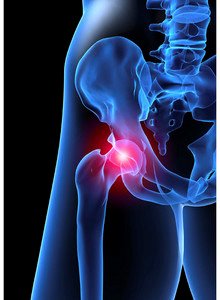Aug. 22, 2008 Research Highlight Biology
Global genetic risk for osteoarthritis
A gene mutation and susceptibility to arthritis are linked in two highly divergent ethnic groups
 Figure 1: A pictorial representation of an inflamed hip as in OA.
Figure 1: A pictorial representation of an inflamed hip as in OA.
An international team of scientists, including Shiro Ikegawa and colleagues at the RIKEN Center for Genomic Medicine (formerly the SNP Research Center) in Yokohama, has reported in the journal Human Molecular Genetics 1 a ‘global’ role for a specific variant, or polymorphism, of a gene in the susceptibility to osteoarthritis (OA). A large-scale statistical analysis of new data shows that mutation of a gene called GDF5 (growth differentiation factor 5) and susceptibility to OA is wide-spread among European and Asian populations.
OA, also known as idiopathic degenerative arthritis, is the most common type of arthritis worldwide, affecting hundreds of millions of people every year. Like many human diseases, OA has several causes, including non-genetic (environment, trauma) factors; however, an underlying genetic component of OA has been clearly established by many studies.
Examining data from the UK and the Netherlands combined with three published European and Asian studies that were previously inconclusive, the researchers used a statistical analysis called meta-analysis to look for evidence of an association between the GDF5 risk gene and susceptibility to OA. Meta-analysis combines data from several individual studies into a single dataset, which can increase the statistical power over that of the individual studies.
Analysis of the combined data—representing more than 11,000 individuals—revealed a significant association of the GDF5 polymorphism and OA susceptibility. However, differences were noted in the risk of developing OA in the hip or the knee: European and Asia individuals in fact have a similar risk for knee OA. But the meta-analysis helped to reveal the significant risk for hip OA in Europeans.
Ikegawa’s team has studied GDF5 for several years, initially linking the specific polymorphism in GDF5 to OA in Asians, and producing mice with the GDF5 mutation. The protein produced by the GDF5 gene is normally involved in joint formation and especially important for development and regeneration of cartilage, the dense but pliable connective tissue on the surface of joints most susceptible to OA, such as the hip (Fig. 1).
Commenting on number of other genes that are known to be associated with genetic risk for OA, Ikegawa says: “In a strict sense, there are none. Only GDF5 and asporin [a second gene Ikegawa’s team previously linked to OA2] have definite functional data supporting the causality of OA, and replication in different ethnic groups.” The paucity of other known genetic factors highlights the importance of the present study for estimating risk for OA.
References
- 1. Chapman, K., Takahashi, A., Meulenbelt, I., Watson, C., Rodriguez-Lopez, J., Egli, R., Tsezou, A., Malizos, K.N., Kloppenburg, M., Shi, D., et al. A meta-analysis of European and Asian cohorts reveals a global role of a functional SNP in the 5' UTR of GDF5 with osteoarthritis susceptibility. Human Molecular Genetics 17, 1497–1504 (2008). doi: 10.1093/hmg/ddn038
- 2. Nakamura, T., Shi, D., Tzetis, M., Rodriguez-Lopez, J., Miyamoto, Y., Tsezou, A., Gonzalez, A., Jiang, Q., Kamatani, N., Loughlin, J. & Ikegawa, S. Meta-analysis of association between the ASPN D-repeat and osteoarthritis. Human Molecular Genetics 14, 1676–1681 (2007). doi: 10.1093/hmg/ddm115
